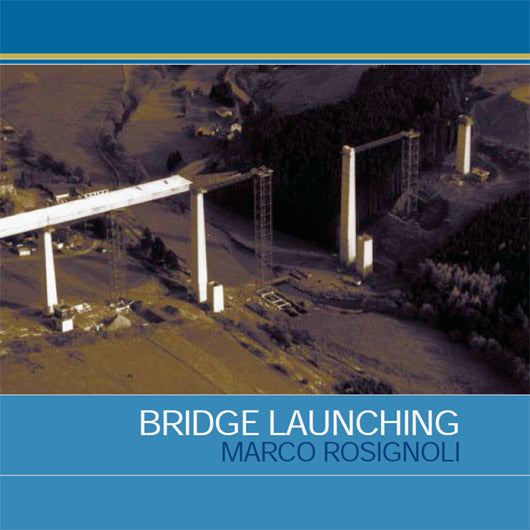
Bridge Launching
Marco Rosignoli
Thomas Telford, ISBN 9780727731463 (2002), p.352, available for purchase:
- At icebookshop.com/ISBN=9780727731463
- By email at orders@icepublishing.com
- From alternate online retailers such as Amazon
I wrote Bridge Launching for Thomas Telford four years after the publication of Launched Bridges (1998, ASCE Press). Addressed to a more international audience, Bridge Launching deepens multiple aspects already discussed in Launched Bridges and includes a brand-new chapter on the incremental launching construction of steel bridges. The book thus covers the design and construction of steel beams, prestressed composite decks comprising concrete slabs and steel corrugated-plate webs, and conventional prestressed-concrete bridges.
Bridge Launching is a comprehensive handbook that integrates the structural, aesthetic and economic aspects of construction techniques for building state-of-the-art structures, offering explanation of both the theoretical and technical aspects of the construction process. The book illustrates the history of the incremental launching method with dozens of case studies that range from the first macro-segmental decks displaced with discontinuous launching on mobile bearings to the modern incremental deck casting technologies and the launch of beam bridges, continuous decks over arches, and cable-stayed decks over temporary piers.
Design tools aimed at optimizing structural design and construction technology are developed and discussed with case studies. The Reduced Transfer Matrix (RTM) method for launch stress analysis of rectilinear decks, design optimization tools for the nose-deck interaction and the front cable-stayed systems, and a closed-form approach to the analysis of the torsion-distortion interaction generated by misaligned launch bearings are formulated and compared with finite-element analysis and statistical data of dozens of launched bridges.
Bridge Launching explores alternative static systems for launched bridges and the different techniques to increase or diminish the level of deck redundancy on launch completions. It explains the use of incremental launching technology in seismic regions and the geometry restraints of incremental launching, side skidding and deck rotation.
- I am a faithful reader of Dr. Rosignoli's book Bridge Launching, a top reference for this constructive procedure - Manuel Escamilla, Associate Professor, Senior Structural Engineer, Pontem (Spain)
- Dr. Rosignoli's researches, publications, skill and expertise in bridge engineering are outstanding: he has spread the incremental launching construction method in Europe and is the world authority in the field - Paolo Mazzalai, Prof.Ing., Dr.Ing., Professor of Applied Engineering, Universita' di Padova (Italy)
- In the light of the relevance, originality, and completeness of his practical contributions and researches, I regard Marco Rosignoli not only as a worldwide-renowned expert, but in fact THE world authority, in the field of bridge launching - John Stanton, PhD, PE, Professor of Civil Engineering, University of Washington (USA)
Pre-sizing techniques and alternative approaches to deck segmentation, cage prefabrication, design of launch post-tensioning and organization of the casting yard are analyzed and compared. Casting stages and launch techniques are thoroughly described along with assessment of design assumptions by means of field monitoring and data recording as well as the launch stress redistribution caused by the time-dependent behavior of concrete. Prestressed-concrete bridges include cast-in-place and precast segmental structures. Composite bridges include I- and box girders. Prestressed composite bridges include stiffened- and corrugated-plate webs.
Bridge Launching formulates new criteria for optimized segmentation of steel girders and new on-site welding techniques employing robotized profile-tracking equipment for their field splices. State-of-the-art analysis tools are formulated for local buckling and torsion-flexure instability of stiffened and corrugated-plate webs and the design of launch noses, front cable-stayed systems, temporary piers and sliding launch bearings for welded girders. Incremental launching of continuous strips of concrete slab over pre-launched steel girders is also discussed and compared with in-place casting with forming carriages.
Launch bearings, guide systems, thrust systems, launch forces, and displacement control systems during uphill and downhill launching are discussed for the different types of construction along with their design and technological requirements. The use of hydraulic launch bearings and skidding shoes is also explained to minimize the limitations of non-launchable deck geometries.
